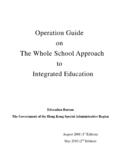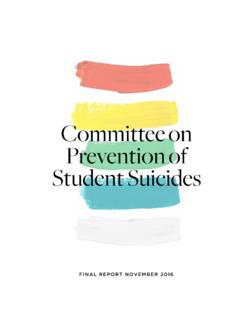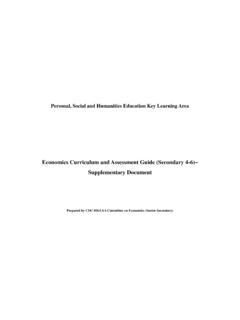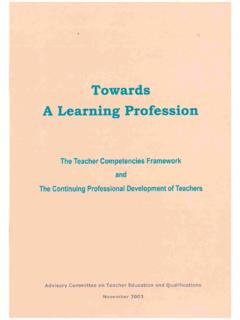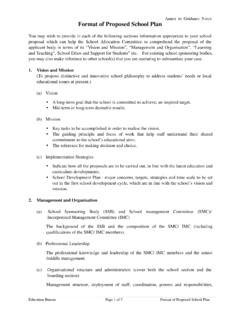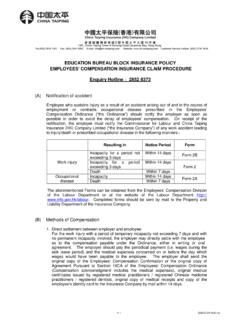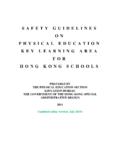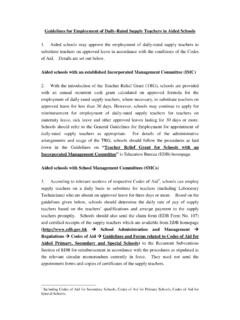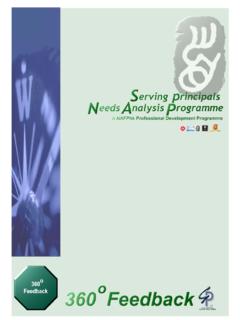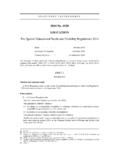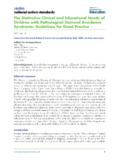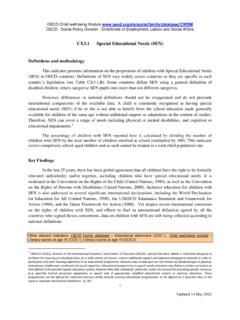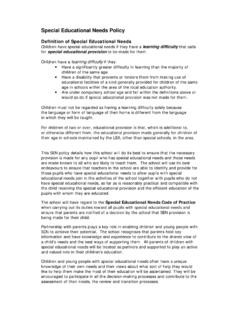Transcription of Inclusive Education for All: A Dream or Reality?
1 Inclusive Education for All: A Dream or Reality? Peter Farrell Professor of special needs and educational Psychology, School of Education , University of Manchester, UK Overview of presentation What do we mean by Inclusive Education ? What can we learn from research on Inclusive Education ? Inclusive Education challenges to improving services Defining inclusion historical overview Up to late 1980 s Integration/mainstreaming referred to placement children with special needs in mainstream schools 1990 s Inclusion replaced the term integration and included an emphasis on improving the quality of Education for pupils with special needs in mainstream schools Since 2000 Inclusion now refers to removing barriers to high quality Education for all children at risk of marginalisation : - Celebrating/responding to diversity in schools and communities DEFINITIONS OF INCLUSION: Some international documents UNESCO (1990) World Declaration on Education for All.
2 Paris: UNESCO.(Jomtien) UNESCO (1994) Final Report: World conference on special needs Education : Access and quality. Paris: UNESCO. (Salamanca) UNESCO (2000) Education for All: Meeting our Collective Commitments. Notes on the Dakar Framework for Action. Paris: UNESCO. UNESCO (2001) The Open File on Inclusive Education . Paris: UNESCO UNESCO (2007&8) EFA Global Monitoring Report: EFA. Strong Foundations: Early Childhood Care and Education . Paris: UNESCO. OECD (2008). Policy brief: Ten steps to equity in Education . Definitions of inclusion embodied in these documents Inclusion focuses on equity and fairness and on the inclusion of all students regardless of disability, gender, ethnicity or other disadvantage. The overall goal is to provide Education for all children, young people, and adults by 2015. (The World Education Forum held in Dakar in April 2000) These documents have been influential in shaping thinking and policy around the world, particularly in developing countries Reflected in the overall mission of NGOs such as EENET ENABLING Education NETWORK (EENET) Inclusive Education : acknowledges that children can learn, acknowledges and respects differences in children s age, gender, ethnicity, language, disability, HIV and TB status etc.
3 , enables Education structures, systems and methodologies to meet the needs of all children is part of a wider strategy to promote an Inclusive society is a dynamic process which is constantly evolving, need not be restricted by large class sizes or a shortage of material resources (EENET, 1998) Messages from National policy documents UK Inspectors (Ofsted) educational inclusion covers: - Equal opportunities (for all pupils regardless of age, gender, ethnicity, attainment, background); The Education of pupils having English as a second language; The Education of pupils with special educational needs including pupils with challenging and disruptive behaviour; Pupils who are gifted or talented. GOVERNMENT INSPECTORS IN ENGLAND AND WALES An educationally Inclusive school is one in which the teaching and learning, achievements, attitudes and well being of every young person matters. Effective schools are educationally Inclusive schools. This shows, not only in their performance, but also in their ethos and their willingness to offer new opportunities to pupils who may have experienced previous The key message: Inclusion is concerned with ensuring that: all children of what ever background have access to high quality Education , they are welcomed by teachers and other staff their contribution is valued Any form of selection based on academic ability, or ability to pay fees is anti Inclusive BUT: Other UK documents The Lamb Inquiry (2009) The Green Paper (2011) Support and Aspiration: A New Approach to special educational needs and Disability Centre for Studies on Inclusive Education (2005) These documents refer to inclusion as being an SEN issue Guidance from Hong Kong (HKSAR) Education Bureau (2007) Teacher professional development framework on integrated Education (13/2007).
4 Hong Kong: Hong Kong Government. Education Bureau. (2007). Whole school approach to cater for students diverse learning needs . Equal Opportunities Commission. (2001). Disability discrimination ordinance: Code of practice on Education . Hong Kong: Equal Opportunities Commission. Hong Kong Government. (1977). Integrating the disabled into the community: An united effort. Hong Kong: Government Printer. Labour & Welfare Bureau. (2009). Convention on the rights of persons with disabilities: Applicable to Hong Kong. Hong Kong: Author. Hong Kong Whole School Approach Promotion of Whole School Approach (WSA) to Inclusive Education ( Education Department, 2002, p. 7) All school personnel, including the school head, teachers, student guidance teacher/officer, non teaching staff, students and parents, are willing to accept students with special needs . Hence, a harmonious environment with a caring, supportive and Inclusive school culture can be established. And WSA will enhance team spirit among teachers, and encourage other school personnel to share responsibilities in looking after students individual differences and special needs The message: Inclusion is an SEN issue So: What DO we mean by inclusion?
5 Is it concerned with ensuring quality and access for ALL children? Is inclusion to do with the Education of children with SEN in mainstream schools, the majority of whom have always been placed there? Is it to do with closing all special schools and relocating the children in mainstream settings? Continuum OR contradiction? INCLUSION: AN OPERATIONAL DEFINITION (the Gold Standard ) Presence:- refers to extent to which pupils attend lessons in mainstream classes in local schools and communities. Acceptance:- refers to the extent to which other staff and pupils welcome all pupils as full and active members of the school Participation:- refers to the extent to which all pupils contribute actively in all the school s activities. Achievement:- refers to the extent to which all pupils make progress in academic skills and in their social/ emotional development. Inclusive Education what can we learn from research? Contrasting/complementary approaches to Inclusive Education research Studies can focus on: - -Outcomes for children, and/or -Factors that affect outcomes Outcomes for children For pupils with SEN, for example: - -Their learning/behaviour/social adjustment For pupils without SEN, for example:- -Impact of iclusive Education on their attainments Typically data is numerical - Assessment/ratings of matched samples of pupils with and without SEN Factors that affect outcomes For example.
6 - Parents views of Inclusive Education Teachers views The role of support staff The impact of staff training on attitudes and knowledge Classroom factors teaching styles, curriculum adaptation Development and evaluation of whole school approaches Studies can incorporate many different approaches surveys, knowledge and attitude measures, structured classroom observations Case studies, action research, focus groups, interviews, ethnographic Some key findings from research on Inclusive Education Inclusion and pupil achievement Role of teaching assistants Leadership that promotes effective whole school approaches in mainstream schools Achievement and support arrangements for students with ID in Hong Kong mainstream and special schools Inclusion and Pupil Achievement Study Key Research Question Are the academic attainments of pupils in Inclusive mainstream schools worse that the attainments of pupils in non- Inclusive schools Methodology Analysis of the National Pupil Data Base (NPD) for all pupils aged 7, 11, 14, 16 NPD includes data on many variables including attainments, SEN status, ethnicity, social class and many others We analysed data on over 500,000 pupils at each KS Summary of main findings There is a very small negative association between inclusivity and attainment.
7 This remains even when a number of other variables are taken into account. But - - it accounts for a very small proportion of pupil scores, and: - it accounts for much less than other variables such as entitlement to free school meals. This relationship may not be causal. In particular, it seems plausible that the populations of schools with large numbers of SEN pupils have other characteristics which lower attainment. Overall there is nothing in the findings to suggest that the commitment to inclusion likely to have an impact on overall levels of attainment. The role of Teaching Assistants (TAs) in making inclusion work. Synopsis of findings from several studies: Terminology TAs, Non teaching assistants, para-professionals etc Huge growth in the numbers of TAs working in mainstream schools 97,000 18500 from 1998 to 2010 in mainstream schools in England and Wales Conditions of service for TAs Little or no qualifications Low pay Temporary contracts Few opportunities for further training BUT: they are often responsible for teaching our most challenging pupils Relationships between the TA and the class teacher Good communication between teachers and TAs TA seen as part of the team and not in school solely to support the child with SEN Teachers and assistants sharing ideas and trusting each other s judgments.
8 Support and teaching arrangements Class teachers taking full ownership of the Education of the pupil with SEN. A possible negative relationship between the amount of one to one support and the extent to which the pupil participates in the life of the school. Effective leadership in mainstream schools to promote whole school approaches to the inclusion of pupils with SEN Methodology Case studies of nineteen primary and secondary schools which had been identified as having strong and effective leadership for inclusion and pupils with SEN Summary of findings Culture and ethos: strong sense of common purpose where emphasis is on the importance of respecting and responding positively to pupils diverse needs . Practice: Practice varied considerably between and within schools. But staff worked together to adapt their lesson plans in response to individuals within their classes. Structures and systems: To support the learning of individual students and to support staff in responding to the challenge of helping children with SEN Management and leadership: Senior staff in the schools were proud of their success in improving the achievement of all children, irrespective of their characteristics, circumstances or impairments.
9 Pupil achievement and support arrangements for students with ID in Hong Kong mainstream and special schools Compared the - academic achievement, - social-emotional functioning, and - self-perceived acceptance of pupils with ID in primary mainstream and special schools Sample 42 students 18 in mainstream (from 16 schools) and 24 in special (3 schools) Sample matched for - age (mean yrs), - IQ ( mild ID range 50-69) - length of time support received (at least 3 years), - parental background Summary of findings Academic achievement of students in mainstream schools was higher than those in special schools Better quality of peer relationships, lower emotional stress levels and more positive self perceptions for pupils in special schools Interpretation of findings Qualitative element of the study interviews and observations in 2 mainstream and 2 special schools Aimed to look at factors that contribute to effective support and student outcomes Findings suggest that the following were important - teacher expectations, - curriculum, - Emphasis on pupil assessments Inclusive Education challenges to improving services Inclusive Education for children in special schools can this be achieved?
10 Some information from the UK of pupils with SEN in special schools - mainly severe and profound LD or SEBD -Virtually all primary aged pupils with Down s syndrome in mainstream school -All barrier free schools -Virtually all pupils with dyslexia in mainstream school -Many children with Aspergers and autism in mainstream school Range of Inclusive provision for children who have traditionally been in special schools in the UK Full time placement in mainstream class with support Mainstream class placement with withdrawal for special work SEN unit/resource base in a mainstream school Co-located special and mainstream school Dual placement in mainstream and special school Occasional visits of pupils from special to mainstream schools Making special Education more Inclusive : issues to address -Transferring good practice from special to mainstream schools -Use of support staff -Preventing in class segregation -Adapting the curriculum -Exam accommodations Making special Education more Inclusive : issues to address (contd.)
